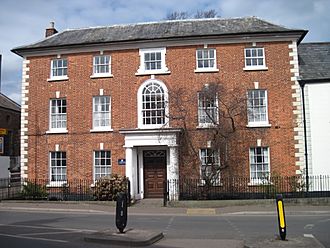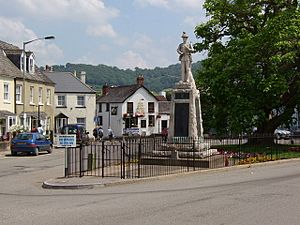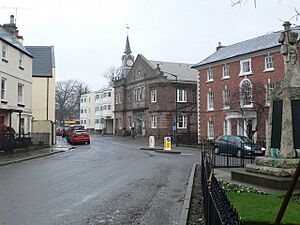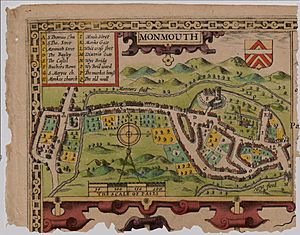St James House, Monmouth facts for kids
Quick facts for kids St James House, Monmouth |
|
|---|---|

St James House at St James Square
and Whitecross Street |
|
| General information | |
| Address | 10 St James Square 10 Whitecross Street |
| Town or city | Monmouth |
| Country | Wales |
| Coordinates | 51°48′48″N 2°42′41″W / 51.813235°N 2.711477°W |
| Designations | Grade II Listed |
St James House is an important old building in Monmouth, Wales. It is a "Grade II listed" building, which means it's officially recognized as special and protected because of its history or architecture. You can find it in the historic St James Square area, right inside the old Medieval town walls that once protected the town.
Even though St James House looks like it's from the 1700s today, it actually started much earlier as a "burgage tenement." This was a type of rental property common in the Middle Ages. Behind the house, archaeologists have even found parts of an old kiln (a type of oven for pottery) with pottery from both Medieval and later times. In 2010, exciting discoveries were made in the square nearby. Archaeologists found evidence of people living in Monmouth during the Mesolithic period (Middle Stone Age) for the very first time! More recently, students from Monmouth School used to live here as boarders.
Contents
Exploring St James Square and Whitecross Street
St James Square is a really pretty spot in Monmouth, known for its old war memorial and a beautiful tree. The Monmouth War Memorial was put in the square in 1921. It was created by a sculptor named W. Clarke. The "romantic-looking tree" is an Indian Bean Tree that was planted around 1900.
St James House is located at the eastern end of Whitecross Street. This street ends at a roundabout that goes around the triangular St James Square. The house sits on the north side of the square. It's across from 33 Whitecross Street, where archaeologists did some digging in 2009.
The area where St James House stands is inside the old Medieval town walls, which were built around the year 1300. An old map of Monmouth from 1610, made by mapmaker John Speed, shows this area right next to the East Gate. In the early 1600s, the square and the road south of it were all considered part of Whitecross Street. There used to be a white cross in the square, which gave the street its name. St James House has had two addresses because of its location: 10 St James Square and 10 Whitecross Street.
The Look and History of St James House
St James House was officially listed as a Grade II building on June 27, 1952. It has a lovely front (facade) that was added in the 1700s. This front has three floors and five sections (bays). It's made of red brick, with lighter-colored stone blocks called quoins at the corners, which stand out against the brick.
Above most of the windows, there are decorative stone pieces called keystones. The windows on the ground and first floors are rectangular, while those on the top floor are square. The tall, round-topped window in the middle of the first floor is special. The main entrance is in the center and has a wooden porch (portico) supported by Doric columns. There's also a fan-shaped window (fanlight) above the door. The roof is sloped and flared. Inside, you can still see some plasterwork from the 1600s.
St James House is a great example of a "burgage tenement" from the Medieval period. A burgage tenement was a long, narrow piece of land, usually in a town, that was rented out. Houses built on these plots often had their narrow side (gable end) facing the street. The back of St James House still shows its original burgage layout. In the 1700s, a new style of building became popular, and many burgage houses, including St James House, got new brick fronts like the one you see today.
Uncovering History: Archaeology at St James House
Many important historical items have been found both at St James House and in the area around it. Behind St James House, archaeologists found proof of a kiln that made pottery after the Medieval period. This kiln produced a specific type of pottery known as A7d. Other kilns in Monmouthshire that made this pottery in the 1600s were in Abergavenny and Trefaldu. Some A7d pottery has also been found outside of Monmouthshire, for example, in Herefordshire. Also, a piece of Spanish pottery found at St James House in 1956 was determined to be from the early 1400s, during the Medieval period.
On November 8, 2010, the BBC News reported an exciting discovery. During work to replace gas pipes in St James Square, archaeologists found flints from the Mesolithic era (Middle Stone Age). This was the first time evidence of human settlement from this very old period had been found in Monmouth.
People Who Lived at St James House
In 1891, a surgeon named Thomas Gilbert Prosser lived at another building called Chippenham House. However, by 1901 and 1911, Dr. Prosser was living at St James House on Whitecross Street. He was listed as a magistrate (a type of judge) and a medical officer at the local Hospital & Dispensary. Dr. Prosser was a member of the Royal College of Surgeons and passed away in Monmouth in 1932.
Another doctor, William Humphrey Williams, followed in Dr. Prosser's footsteps. He also became a member of the Royal College of Surgeons. By 1923, Dr. Williams was the Medical Officer of Health for Monmouth, and his family lived at St James House. He was also a medical officer for other local areas and the Borough Fever Hospital. Dr. Williams and his wife lived at St James House until his death in 1948.
Later, St James House became a junior boarding house for boys aged ten to thirteen who attended Monmouth School. A person named A J Jones was a housemaster there. In 2011, Monmouth School started a big renovation project. As part of this project, St James House was sold. The boarding students who lived there moved to Chapel House in September 2011. The school also changed The Grange from a prep school into a boarding house for older students (sixth form).
Images for kids





